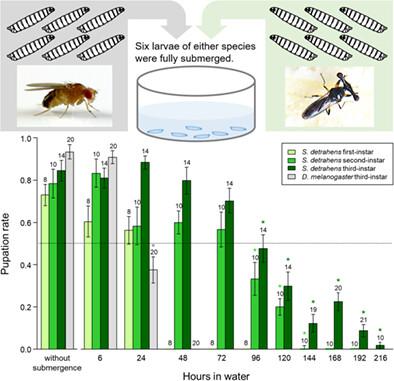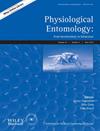Submergence tolerance in immature stages of the stalk-eyed fly Sphyracephala detrahens (Diptera: Diopsidae)
IF 1.5
4区 农林科学
Q2 ENTOMOLOGY
引用次数: 0
Abstract
Sphyracephala detrahens (Walker, 1860) (Diptera: Diopsidae) inhabits the riparian zones of streams and rivers. Because of the limited dispersal ability of S. detrahens during egg, larval, and pupal stages, immature individuals are at risk of being submerged by floodwater after heavy rain. In this study, I evaluated the submergence tolerances of immatures of S. detrahens by comparing them to immatures of Drosophila melanogaster, which also feed on rotten fruits but are not restricted to the riparian zone. The results showed that S. detrahens eggs were susceptible to desiccation, but more than 80% of eggs hatched after full submergence. Later instar larvae were more resistant to full submergence than earlier instar larvae. The duration of submergence causing 50% pupation (PD50) in the first, second, and third‐instar larvae of S. detrahens were 15.88, 58.46, and 91.74 h, respectively. The PD50 of the third‐instar larvae of D. melanogaster was 20.01 h. Third‐instar S. detrahens larvae continued to develop in water for a longer duration than D. melanogaster larvae of the same instar. In the pupal stages, late pupae tended to remain afloat longer than early pupae. The duration of submergence causing 50% emergence (ED50) of adults from early and late pupae were 40.70 and 104.74 h, respectively. In the larval and pupal stages, individuals in the later developmental phases tended to be more tolerant to full submergence. The submergence tolerance of the immature stages of S. detrahens may reflect adaptation to an environment with fluctuating water levels.

柄眼蝇成虫未成熟期的耐淹性(直翅目:直翅目)
逼尿鱼鞘翅目(Walker,1860)(直翅目:直翅目)栖息在溪流和河流的河岸地带。由于逼尿鱼在卵、幼虫和蛹阶段的扩散能力有限,未成熟个体在大雨后有被洪水淹没的风险。在这项研究中,我通过将其与黑腹果蝇(Drosophila melanogaster)的未成熟体进行比较,评估了去花鼠幼体的耐淹性,黑腹果蝇也以腐烂的水果为食,但不限于河岸带。结果表明,逼尿鱼卵易干燥,但80%以上的卵在完全浸没后孵化。晚龄幼虫比早龄幼虫更能抵抗完全淹没。1龄、2龄和3龄逼尿鱼幼虫50%化蛹(PD50)的淹没持续时间分别为15.88、58.46和91.74 h、 分别。黑腹果蝇三龄幼虫的PD50为20.01 h.与同龄黑腹果蝇幼虫相比,三龄逼尿鱼幼虫在水中持续发育的时间更长。在蛹期,晚期蛹往往比早期蛹漂浮的时间更长。从早蛹到晚蛹,造成成虫50%羽化(ED50)的淹没持续时间分别为40.70和104.74 h、 分别。在幼虫和蛹阶段,处于后期发育阶段的个体往往更能耐受完全淹没。去顶黄颡鱼未成熟阶段的耐淹性可能反映了对水位波动环境的适应。
本文章由计算机程序翻译,如有差异,请以英文原文为准。
求助全文
约1分钟内获得全文
求助全文
来源期刊

Physiological Entomology
生物-昆虫学
CiteScore
2.80
自引率
6.70%
发文量
21
审稿时长
>12 weeks
期刊介绍:
Physiological Entomology broadly considers “how insects work” and how they are adapted to their environments at all levels from genes and molecules, anatomy and structure, to behaviour and interactions of whole organisms. We publish high quality experiment based papers reporting research on insects and other arthropods as well as occasional reviews. The journal thus has a focus on physiological and experimental approaches to understanding how insects function. The broad subject coverage of the Journal includes, but is not limited to:
-experimental analysis of behaviour-
behavioural physiology and biochemistry-
neurobiology and sensory physiology-
general physiology-
circadian rhythms and photoperiodism-
chemical ecology
 求助内容:
求助内容: 应助结果提醒方式:
应助结果提醒方式:


